The approximate 6,000 ships that have succumbed to raging storms attest to the power of the Great Lakes. As I traveled, writing and compiling information for my three-volume travel series, Exploring Michigan's Coasts, I heard or read the tales left behind by those ill-fated ships. They add a somber, but compelling backdrop to Michigan’s waterways.
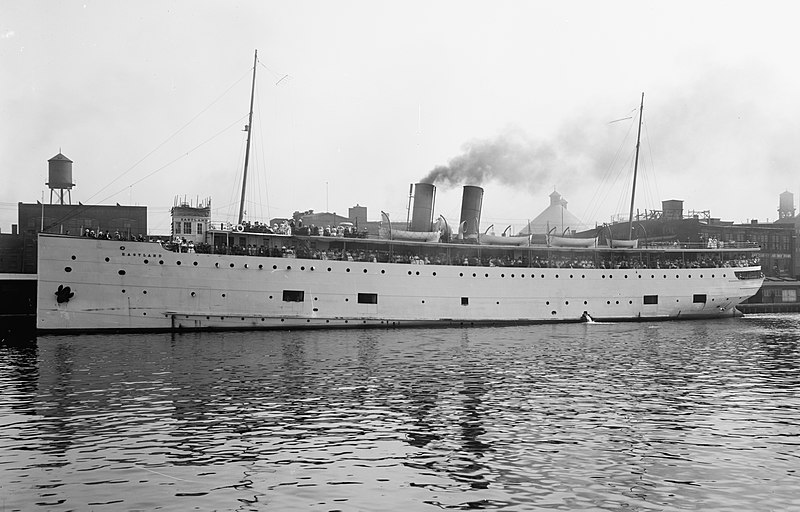
The S.S. Eastland, in Cleveland, Ohio, around 1911.
The Eastland remains the oddest tragedy ever to befall a ship on Lake Michigan. She met her demise on July 24, 1915, but not due to a raging storm or even in open water.
The Eastland was tied to the dock at the Clark Street Bridge in the narrow channel of the Chicago River when tragedy befell her. She was a relatively young ship, with only ten years of service on the lakes. She weighed 1,900 tons. Captain Harry Pederson was at her helm.

Post card with photograph of the Eastland, with superimposed text written across the top: "S.S. Eastland at the Michigan City Docks" and "Capt H. Pederson" with a superimposed photograph of a man, perhaps, "Capt. H. Pedersen."
The channel was as unlikely a spot for this senseless mishap as could have been envisioned. The Eastland was preparing to transport 2,500 Western Electric Company passengers to a pleasant holiday across the beautiful lake to the Michigan dunes. Some estimates conclude that perhaps there were 3,000 aboard a ship designed to carry only 2,500. The final investigation determined that overcrowding was not a significant issue in the disaster.

Eastland disaster Chicago River 1915
Passengers began boarding at 7:00 a.m. to get an early start on the day’s festivities. Ragtime music floated in the air as happy revelers stowed picnic baskets and engaged in lighthearted chatter with friends and colleagues. Skies were overcast with spitting drizzle, but the precipitation could not dampen the spirits of travelers on holiday. Only those on the main deck heard the cries, “Look out, the boat’s turning over!” For the moment, it barely caused a pause in their conversations, so certain were those aboard that the cry must be in jest.
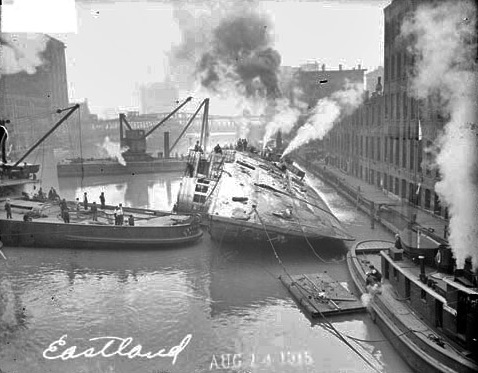
The steamer Eastland being righted after capsizing in the Chicago River near the Loop community. Chicago Daily News, Inc., photographer.
But something was definitely amiss. The great ship tilted toward the dock. Captain Pederson attempted to correct the situation and ordered the sea cocks opened to tip the ship. She uprighted but then listed at a dangerous angle away from the dock. Passengers who had gone below found themselves smashing against the bulkheads. Bottles and other loose items crashed about. Chairs on deck slid from starboard to port. The icebox in the refreshment stand tore loose and skidded across the deck.
Many passengers fearing for their lives jumped overboard. By 7:30 a.m., the demon-possessed ship overturned in the river with her starboard side upward above the water. Passengers caught in the confusion panicked. Many drowned within a few feet of the dock. Hundreds more were trapped in cabins below the decks. A few lucky passengers crawled through portholes, and a few more were still alive when rescuers with acetylene torches cut a path to safety.

On July 24, 1915, Bob Satterfield was crossing the Clark Street Bridge on his way to work, when he witnessed the capsizing of the SS Eastland. He watched the rescue attempts, and drew this sketch that morning, while it was still fresh in his mind. It was published on July 27, 1915
No satisfactory reason has been offered to explain the erratic behavior of an otherwise predictable ship. One of the first theories was that the passengers all crowded to one side to watch a tug pass. That theory was discarded at the inquest. Improper ballast may have been the cause, but no one will ever know for sure. The ship was in fine condition and continued to sail after the tragic incident. She was renamed the U.S.S. Wilmette and was converted to a naval training ship. Most who saw her moored at the Randolph Street dock in Chicago had no indication that the U.S.S. Wilmette had been the Eastland in her prior life. They simply stood and admired her clean lines and sharp appearance.
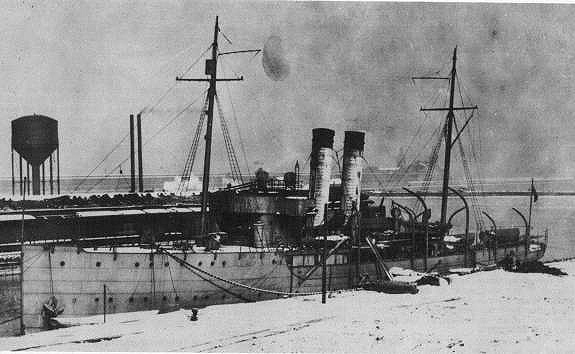
Photo of the USS Wilmette cira 1918
Captain Pederson and steamship company officials were charged with criminal negligence, but a U. S. Circuit Court of Appeals ultimately issued a decision that the boat was seaworthy, and the operators had acted appropriately. That decision closed the legal aspect of the case. It did not close the public’s indignation that the ship had caused the loss of half as many lives as had been doomed on the Titanic three years earlier with no satisfactory explanation. The Titanic could be explained, an iceberg, a cocky attitude that she was unsinkable, a speed to set records, and a lack of visibility. But the Eastland? She had never moved out of the channel. It was unthinkable.
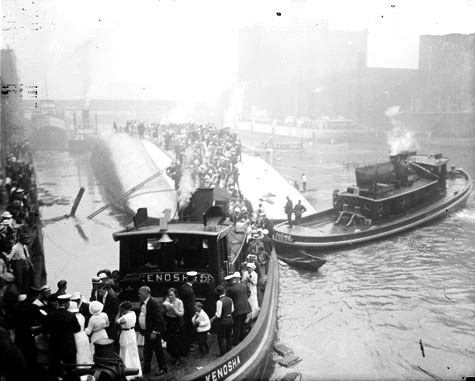
Eastland disaster, the Kenosha, a tugboat, rescuing survivors from the hull of the overturned steamer. Chicago Daily News, Inc., photographer.
The ship, however, had been the target of ugly rumors about her safety for years. So persistent were the stories that the owners of the Eastland resorted to taking out a half-page advertisement in the Cleveland Plain Dealer. The ad praised the ship for her strength, her safety record, and the joy her excursions had brought to thousands of happy, satisfied passengers. It went on to offer a $5,000 reward, “we offer the above reward to any person that will bring forth a naval engineer, a marine architect, a ship builder, or anyone qualified to pass judgment on the merits of a ship who will say that the steamer Eastland is not a seaworthy ship, or that she would not ride out any storm, or weather any condition that can arise on either lake or ocean.”
Whatever the cause, on a hot steamy day in July, the Eastland became possessed, and more than 800 people died, among them 22 entire families. Those gruesome statistics earned her the dubious distinction of the worst loss of lives in one accident on the Great Lakes. It was a record that would hopefully never be broken.
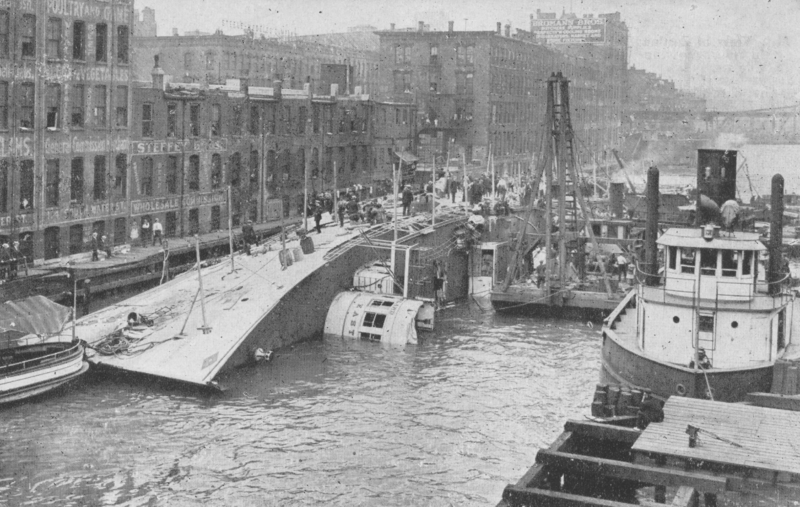
View of Eastland taken from Fire Tug in river, showing the hull resting on its side on the river bottom. The work of recovering bodies is being carried on with untiring effort.
Click through to read excerpts from Royce's three books exploring Michigan's coasts:
Julie Albrecht Royce, the Michigan Editor for Wandering Educators recently published a three-book travel series exploring Michigan’s coastlines. Nearly two decades ago, she published two traditional travel books, but found they were quickly outdated. This most recent project focuses on providing travelers with interesting background for the places they plan to visit. Royce has published two novels: Ardent Spirit, historical fiction inspired by the true story of Odawa-French Fur Trader, Magdelaine La Framboise, and PILZ, a legal thriller which drew on her experiences as a First Assistant Attorney General for the State of Michigan. She has written magazine and newspaper articles, and had several short stories included in anthologies. All books available on Amazon.

Help promote Michigan. Books available on Amazon.

